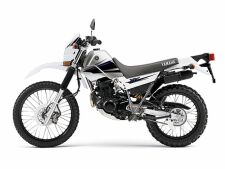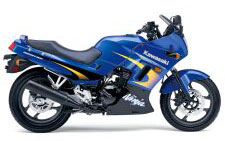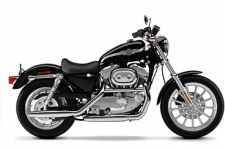 Engine
Roar Lore: How Should A Motorcycle Sound? Engine
Roar Lore: How Should A Motorcycle Sound? |
by
Tom Andrews
Co-Founder
Beginner Bikes Magazine
 When
you think, "motorcycle," does a specific sound accompany
the image that comes to mind? It does for me. Because I grew up
on motocross racing, a 125cc two-stroke motocross bike, its banshee
wail at high rpm, will always be the sound I associate with motorcycling
at its most exciting and intense. When I purchased my own 125cc
motocrosser, I couldn't get enough of keeping the engine "on
the pipe," in the meat of the power band, simply to hear the
sound that so enchanted me. I also love to distraction the potent
sound of a large-displacement, in-line four-cylinder engine at low
rpms; like that of, say, Suzuki's Bandit 1200 or Honda's CBR1100XX.
Withheld and implied energy is sometimes more enticing than the
actually display of it. These days there are many different engine
configurations to choose from when buying a bike, each with its
own distinctive sound and power characteristics. When
you think, "motorcycle," does a specific sound accompany
the image that comes to mind? It does for me. Because I grew up
on motocross racing, a 125cc two-stroke motocross bike, its banshee
wail at high rpm, will always be the sound I associate with motorcycling
at its most exciting and intense. When I purchased my own 125cc
motocrosser, I couldn't get enough of keeping the engine "on
the pipe," in the meat of the power band, simply to hear the
sound that so enchanted me. I also love to distraction the potent
sound of a large-displacement, in-line four-cylinder engine at low
rpms; like that of, say, Suzuki's Bandit 1200 or Honda's CBR1100XX.
Withheld and implied energy is sometimes more enticing than the
actually display of it. These days there are many different engine
configurations to choose from when buying a bike, each with its
own distinctive sound and power characteristics.
We
at BEGINNER BIKES thought it might be useful to describe
the various motorcycle engines, their sounds and personalities,
and ask you if you had a favorite. But have you ever tried to
describe a sound? Descriptive language tends to be visual in nature;
describing aural phenomena is a challenge indeed. We asked Brett
Blacketer of Action MotorSports in Lafayette, Indiana, one of
America's unsung motorcycling heroes, to help us out. Typically,
he came through for us in brilliant fashion. Here's what he wrote:
Single-cylinder
four-stroke engine:
Like hearing and riding a warthog; real quick and grunty,
just not a lot of top-end. Just might startle you with a wheelie.
Twin-cylinder
four-stroke engine:
Like a moose; not the prettiest thing at a walking
pace, but graceful when at full song. Tuck in and smile as
the gait is your lullaby, bwump bwump bwump bwump. Like all
good dreams, things are moving much faster than you think.
Two-stroke
engine:
Like a cheetah; lots of speed and precision, just not a lot
of power. Twist it and think ahead, because momentum is king.
Three-cylinder
four-stroke engine:
Misunderstood and hard to capture animals. Great
hunters, but in the middle of the food chain.
In-line
four-cylinder engine:
The howl and wail of a racing greyhound. Pure
power and rippling muscles. Point it and twist the giggle
stick, try to make that heart beat a few more revs because
too much is never enough.
I
also asked Brett to describe one of my favorite engines, Honda's
V-Four, with its four cylinders set in a "V" formation
rather than in a straight-line. This engine's cams are driven
by gears rather than chains, and is found in the VFR and Magna
series (excluding the Magna 250, a twin-cylinder bike not available
in the U.S.):
Honda
gear-driven-cam V-four engine:
Like a rhino: grunty, smooth, shockingly quick
to rev, unstoppable at any speed. Not the fastest, but the
most willing to traverse any conditions in a confident and
powerfully sophisticated manner.
In
the context of BEGINNER BIKES, most of the cruisers we
review have V-twin engines, and all of the dual-sport
bikes we review have single-cylinder engines.  The
standards
and sportbikes mostly
feature twin-cylinder engines, but they vary in terms of sound
and power. Brett's description of in-line fours fits the Kawasaki
Ninja 250's parallel-twin engine perfectly, as
it revs to an astral 14,000 rpm. Riding it, you can't believe
you can keep twisting the throttle, but you can and do "because
too much is never enough." No other twin we review behaves
this way or has such a shriek when revved to its redline. The
standards
and sportbikes mostly
feature twin-cylinder engines, but they vary in terms of sound
and power. Brett's description of in-line fours fits the Kawasaki
Ninja 250's parallel-twin engine perfectly, as
it revs to an astral 14,000 rpm. Riding it, you can't believe
you can keep twisting the throttle, but you can and do "because
too much is never enough." No other twin we review behaves
this way or has such a shriek when revved to its redline.
Federico
Minoli, CEO of Ducati, brags that his nine-year-old son, Daniel,
can identify motorcycles by sound. "Daniel says a Harley
goes potato-potato-potato," Minoli says. "A 600cc Japanese
sportbike goes whee-whee-whee. A Ducati goes vroom-vroom-vroom."
Harley-Davidsons
and Ducatis have arguably the most distinctive sounds now going,
and in fact Harley-Davidson tried for years to copyright the sound
of its big twin. Just as the MGM lion is a copyrighted sound,
they argued, so is the Harley roar worthy of legal protection.
 The
lawsuit failed, but it doesn't matter: a Harley's roar is like
none other; which is why aftermarket companies work day and night
to offer exhaust pipes which approximate the sound of the Milwaukee
machine. If imitation is the sincerest form of flattery, Harley
has been blushing for decades. More recently, Honda and Suzuki
have introduced large-displacement sporting twins to compete head
to head with Ducati. Their efforts have resulted in truly wonderful
motorcycles; especially Honda's VTR1000 Super Hawk--that have
found their own constituency. Nevertheless, they lack Ducati's
distinctive sound and exclusivity and have failed to encroach
on Ducati's market share. The
lawsuit failed, but it doesn't matter: a Harley's roar is like
none other; which is why aftermarket companies work day and night
to offer exhaust pipes which approximate the sound of the Milwaukee
machine. If imitation is the sincerest form of flattery, Harley
has been blushing for decades. More recently, Honda and Suzuki
have introduced large-displacement sporting twins to compete head
to head with Ducati. Their efforts have resulted in truly wonderful
motorcycles; especially Honda's VTR1000 Super Hawk--that have
found their own constituency. Nevertheless, they lack Ducati's
distinctive sound and exclusivity and have failed to encroach
on Ducati's market share.
So,
what's your favorite motorcycle sound? How important is sound
to you as you consider which bike to purchase? Let us know what
you think.
Sound
off here! |

